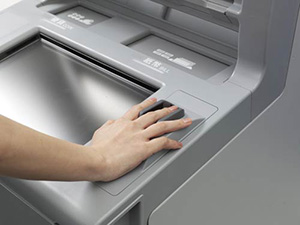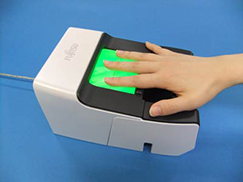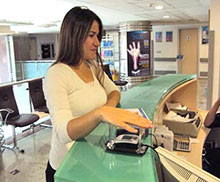Web Japan > Trends in Japan > Tech & Life > Leading the world with speed and accuracy
Leading the world with speed and accuracy
Japan’s Biometric authentication technology using palm vein patterns

Terminal of the world’s smallest palm vein authentication device (courtesy of Fujitsu)
Under a situation where the risk of cybercrime has increased, such as through personal information leakage and unauthorized reading of bank card information, more robust information protection measures are required. One of the most important among these measures is personal identification. “Biometric authentication,” which uses biological information only possessed by the identifier such as fingerprint, face and the eye-iris, is gathering attention as a technology that accomplishes this quickly and accurately. In particular, authentication technology using vein patterns of the hand or finger—which Japanese companies have made efforts to develop—is one of the definitive choices for biometric authentication, given that there is no need to worry about the shape changing with age or the vein being duplicated. Vein pattern authentication displays one of the world’s best performances in accuracy and speed.
Precursors of the commercialization of fingerprint sensors
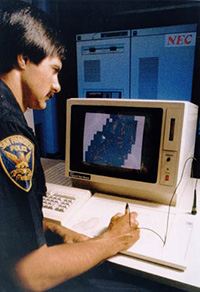
Fingerprint matching system introduced into the San Francisco Police Department (courtesy of NEC, photo taken in the 1980s)
“Biological body” used in biometric authentication, which everyone possesses just like one’s body part and has features only attributable to the identifier, signifies the biological information that remains unchanged throughout one’s lifetime. Humankind has adopted authentication since ancient times. For instance, the Babylonian Dynasty in pre-Christian times put fingerprints on their possessions. However, this system has only been adopted in earnest since the 1970s, when it became possible to save and search massive information on the computer. A system that automatically matches characteristics of a fingerprint, which was developed by a Japanese manufacturer for crime investigation purposes, was introduced into the Metropolitan Police Department in Japan and San Francisco Police Department in the U.S, becoming the precursors of fingerprint sensors today.
Since then, “fingerprint” has been representative of biological bodies, but there are cases where contact-type fingerprint authentication has difficulty matching data, depending on the condition of the hand’s surface skin. As a result, Japanese manufacturers have been researching vein authentication systems in addition to fingerprints since 1990s. The characteristic of veins is that they are hard to duplicate because they are inside the body and they provide stable authentication results. Their practical applications have rapidly progressed since the beginning of the 21st century.
Identifies 10 million people within two seconds
The mechanism of typical vein authentication is to match vein information by placing the palm or finger above the device and displaying the light absorbed by hemoglobin in blood exposed to near infrared irradiation. Among the vein authentication devices using palm information developed by Japanese manufacturers, there are some that have 100 times the accuracy of fingerprint authentication devices. In addition, when there are many registered data, such as at the scale of 10 million people, there are cases in which differences with other people cannot be distinguished only by one type of biological information. In response to this, Japanese manufacturers have focused on a hybrid authentication system that combines information from the palm vein and fingerprint of three fingers. Just with a single touch by placing one’s hand on top of the device, this world’s cutting-edge device can identify a person from among a data at the scale of 10 million people within two seconds. It is expected to be utilized for administrative services and social infrastructure, which have a large number of registrants.
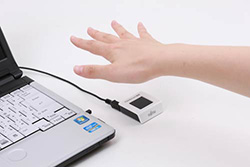
Logging into your computer simply by placing your hand over the attached palm vein authentication device (courtesy of Fujitsu)
Development of an ultra-small, four-gram sensor
Reduction of size and weight is also the specialty of Japanese manufacturers. In recent years, development for mounting vein authentication systems on computers and tablet information devices is progressing at a rapid pace. Although fingerprint authentication has been put to practical use in some models of computers and smartphones, the reality is that these equipped models are still limited. In terms of security systems for the rapidly spreading smartphones, a next-generation vein authentication is more effective. In April 2013, a Japanese manufacturer announced the practical realization of an ultra-small sensor, which is the world’s smallest, thinnest and lightest device weighing just four grams.
Building a safe and convenient society
Left: Terminal of a hybrid authentication device that matches 10 million data within two seconds (courtesy of Fujitsu)
Right: Photo of using palm vein authentication at a hospital reception in Turkey (courtesy of Fujitsu)
Japanese biometric authentication technology—which is making improvements in authentication accuracy, speed and ease of use on a daily basis—has been highly valued in countries abroad and has been introduced one after another. In a major bank in Brazil, palm vein authentication has been adopted in ATM user authentication, managing a scope of 10 million customers. In China, given the frequent occurrence of unauthorized receipt of social insurance by spoofing, the Social Insurance Agency such as in Henan Province has introduced palm vein authentication and shown results in identification. A major bank in Turkey has also implemented a finger vein authentication system.
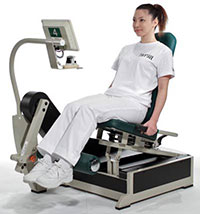
Customized programs that are tailored to each user provided by installing a finger vein authentication device in fitness machines (courtesy of Hitachi)
Recently, there are increasingly more cases of introducing these technologies not only as a measure for bank card security, but also for the purposes of eliminating congestion in reception counters such as in libraries, universities, municipalities, hospitals, fitness clubs and more. The development of biometric authentication technology by Japanese manufacturers carries high expectations towards the creation of a safe and convenient social system.
(July 2013)

